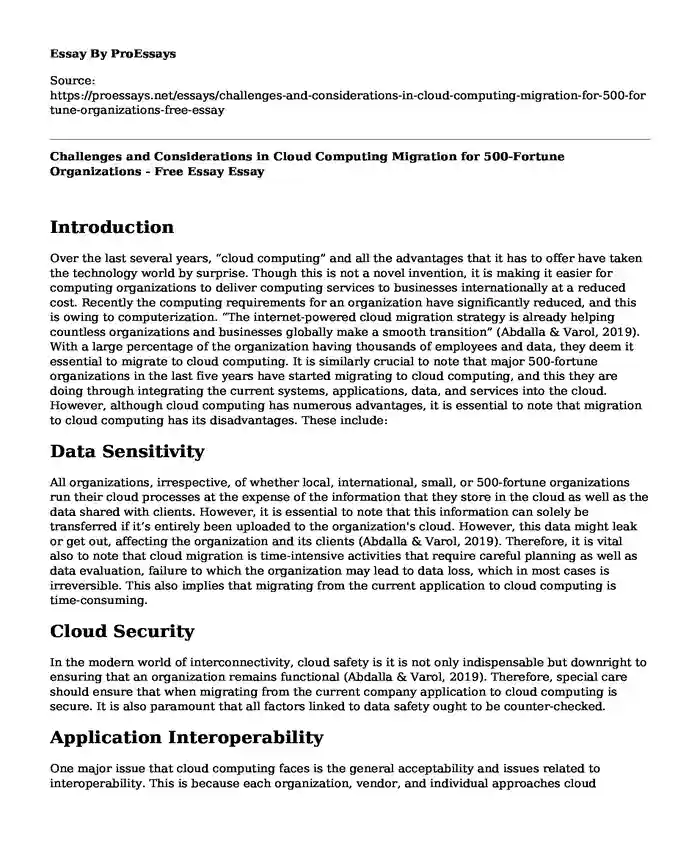Introduction
Over the last several years, “cloud computing” and all the advantages that it has to offer have taken the technology world by surprise. Though this is not a novel invention, it is making it easier for computing organizations to deliver computing services to businesses internationally at a reduced cost. Recently the computing requirements for an organization have significantly reduced, and this is owing to computerization. “The internet-powered cloud migration strategy is already helping countless organizations and businesses globally make a smooth transition” (Abdalla & Varol, 2019). With a large percentage of the organization having thousands of employees and data, they deem it essential to migrate to cloud computing. It is similarly crucial to note that major 500-fortune organizations in the last five years have started migrating to cloud computing, and this they are doing through integrating the current systems, applications, data, and services into the cloud. However, although cloud computing has numerous advantages, it is essential to note that migration to cloud computing has its disadvantages. These include:
Data Sensitivity
All organizations, irrespective, of whether local, international, small, or 500-fortune organizations run their cloud processes at the expense of the information that they store in the cloud as well as the data shared with clients. However, it is essential to note that this information can solely be transferred if it’s entirely been uploaded to the organization's cloud. However, this data might leak or get out, affecting the organization and its clients (Abdalla & Varol, 2019). Therefore, it is vital also to note that cloud migration is time-intensive activities that require careful planning as well as data evaluation, failure to which the organization may lead to data loss, which in most cases is irreversible. This also implies that migrating from the current application to cloud computing is time-consuming.
Cloud Security
In the modern world of interconnectivity, cloud safety is it is not only indispensable but downright to ensuring that an organization remains functional (Abdalla & Varol, 2019). Therefore, special care should ensure that when migrating from the current company application to cloud computing is secure. It is also paramount that all factors linked to data safety ought to be counter-checked.
Application Interoperability
One major issue that cloud computing faces is the general acceptability and issues related to interoperability. This is because each organization, vendor, and individual approaches cloud computing to make it difficult for a single application to interconnect with others (Says et al., 2020). In an ideal cloud computing world, a single code ought to operate across multiple submissions established by several diverse vendors or organizations. However, this is not the case. Therefore, the 500-fortune organization should consider the interoperability measure between the organization and its subsidiaries and suppliers, and the company application function together.
The Cost and Time for Cloud Migration
When implementing the enterprise-wide cloud computing migration to the 500-fortune company, it is crucial to consider the time the proves will take on top of the cost involved in the migration. It is important to note that the bandwidth costs involved in the migration process will be substantially high. The time taken will impact the employee’s productivity in several areas of operations (Says et al., 2020).
Business Downtime
Good interment connectivity is paramount with access to cloud data uploads and downloads files from the cloud after the company has successfully migrated its data to the cloud. This means that in case the company loses internet connectivity or has no access to the cloud database, it means that there will be business downtime until the company has access to the cloud (Says et al., 2020). There the company must retain constant access to an internet connection while and after migrating its data to the cloud.
Conclusion
With all the disadvantages, cloud computing still exists, and it offers numerous advantages that support all organizations, both small and 500-fortune organizations. It provides the organization with an opportunity to reduce the costs of its information technology management costs. However, there are critical issues concerning data security, time and costs of migration, interoperability, business downtime, and data sensitivity. Therefore, the 500-fortune organisation needs to make the necessary plans to ensure that the migration plans as more benefits than disadvantages.
References
Abdalla, P. A., & Varol, A. (2019). Advantages to Disadvantages of Cloud Computing for Small-Sized Business. 2019 7th International Symposium on Digital Forensics and Security (ISDFS). doi:10.1109/isdfs.2019.8757549
Says:, K., Says:, L., Says:, S., & Says:, K. (2020, September 17). Advantages and Disadvantages of Cloud Computing - Intellipaat. Intellipaat. https://intellipaat.com/blog/tutorial/amazon-web-services-aws-tutorial/advantages-and-disadvantages-of-cloud-computing/
Cite this page
Challenges and Considerations in Cloud Computing Migration for 500-Fortune Organizations - Free Essay. (2023, Dec 29). Retrieved from https://proessays.net/essays/challenges-and-considerations-in-cloud-computing-migration-for-500-fortune-organizations-free-essay
If you are the original author of this essay and no longer wish to have it published on the ProEssays website, please click below to request its removal:
- Paper Example on Operational and Supply Issues at Maudsley Hospital
- Environmental Scan for Starbucks Company - Essay Sample
- Modern Technology and Social Change Essay
- Essay Example on Walmart's Expansion: Benefits, Threats, and Challenges in Global Markets
- Cybersecurity: Defending Against 21st Century Threats - Annotated Bibliography
- Essay Example on Difference Between Quality Improvement & Quality Assurance
- Essay Sample on Gamification: Enhancing Learning with Fun and Excitement







